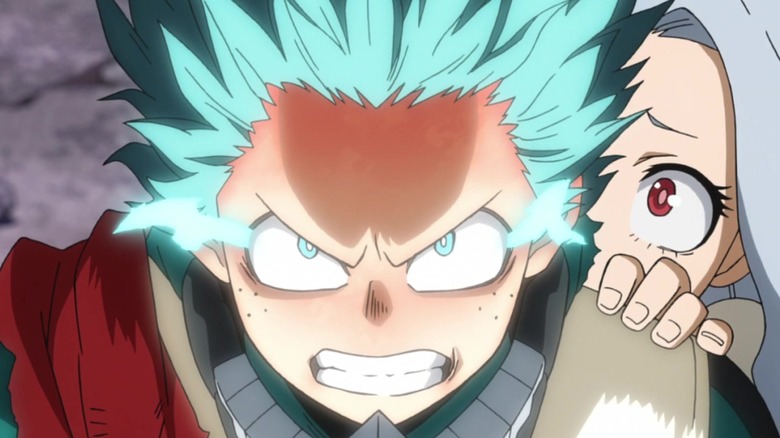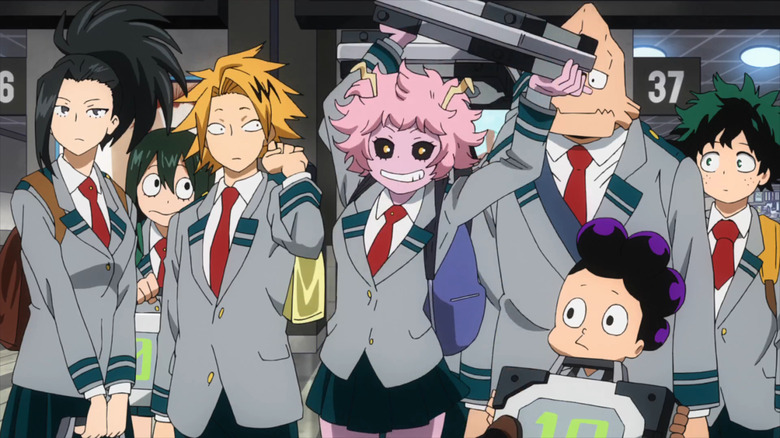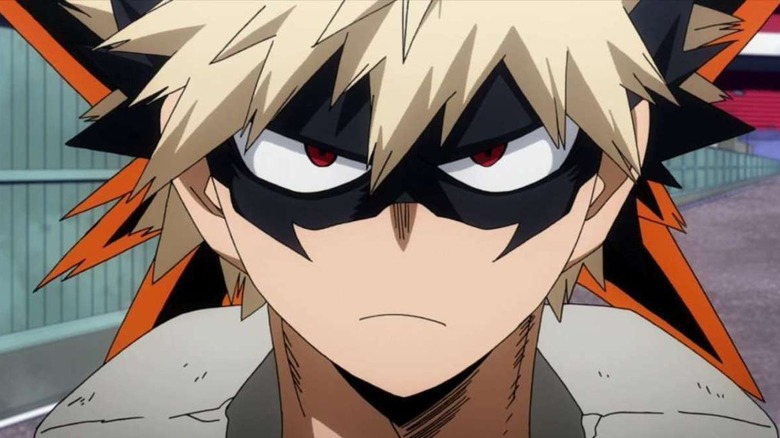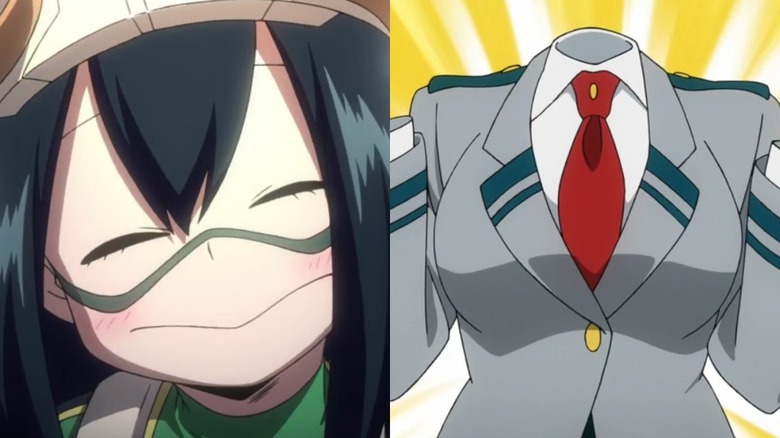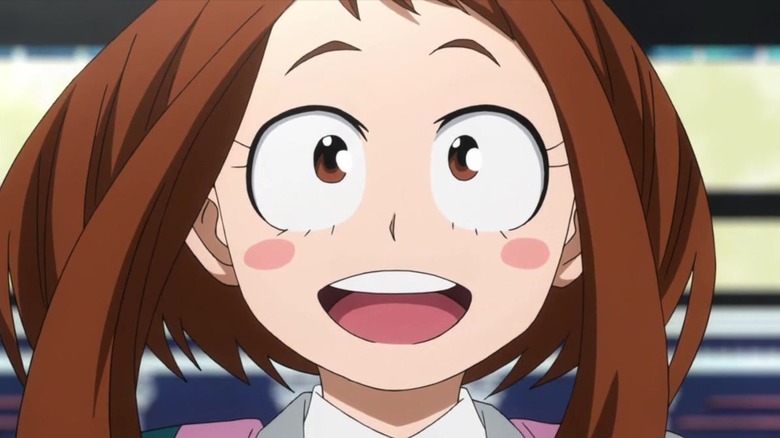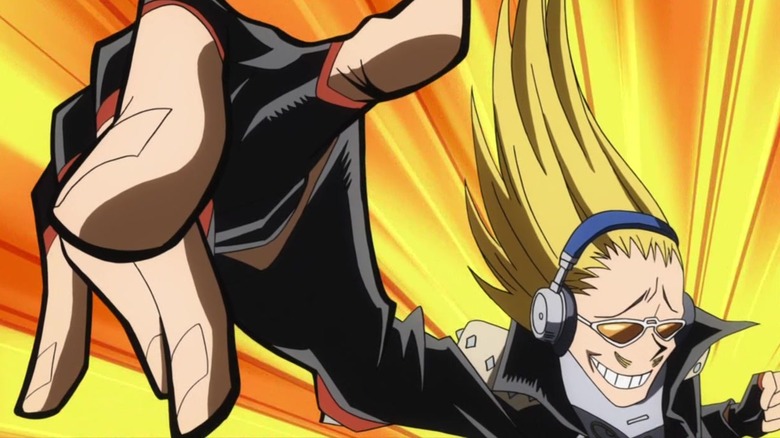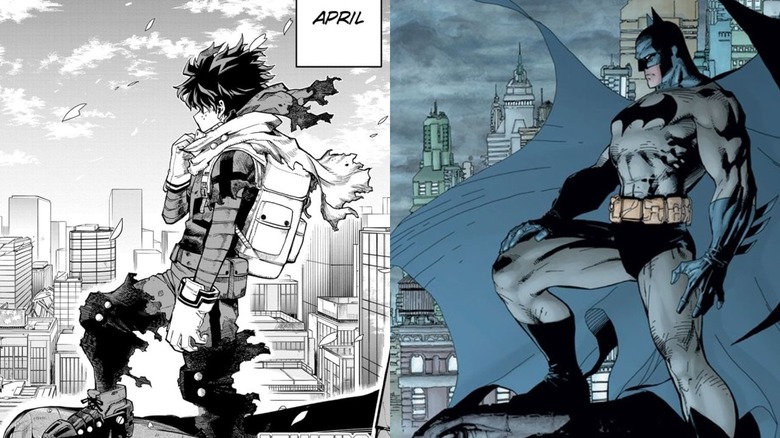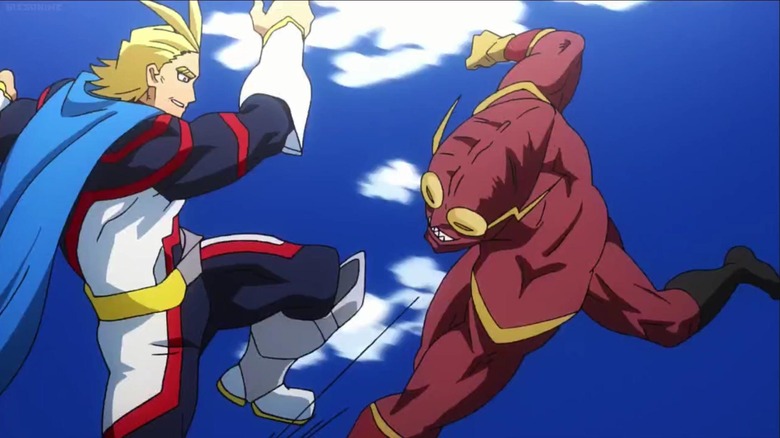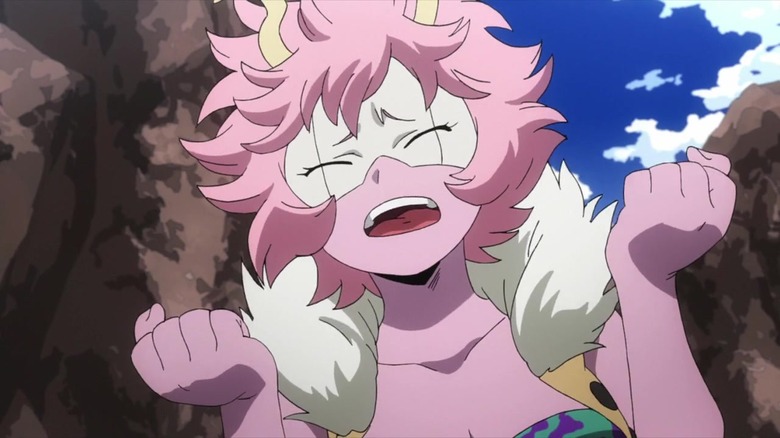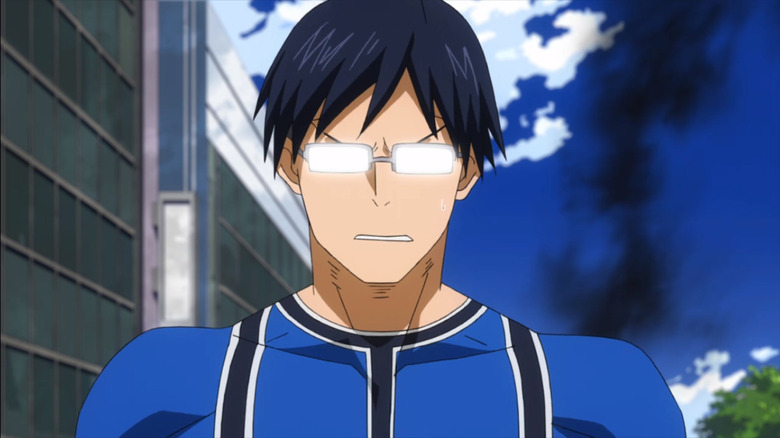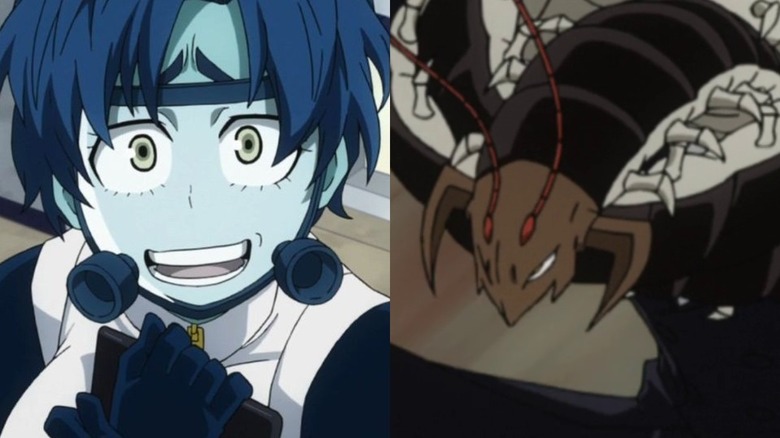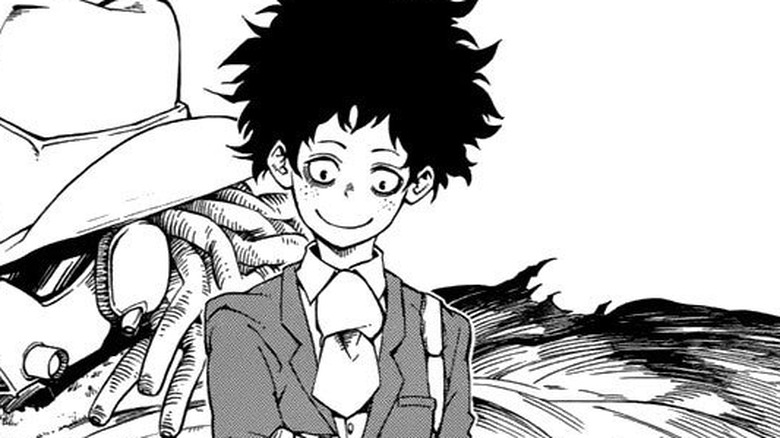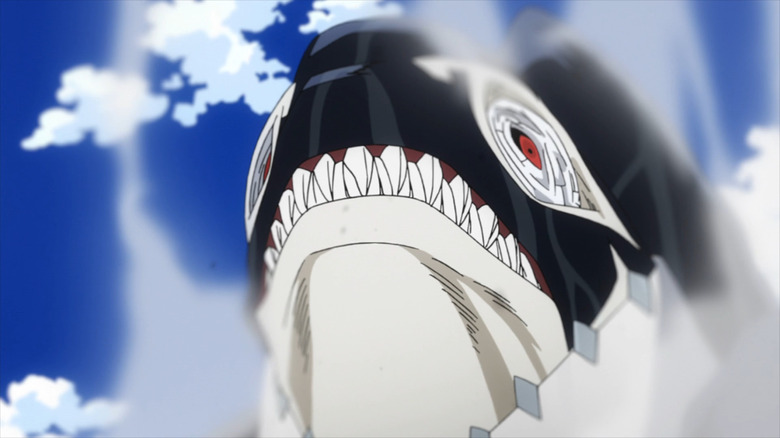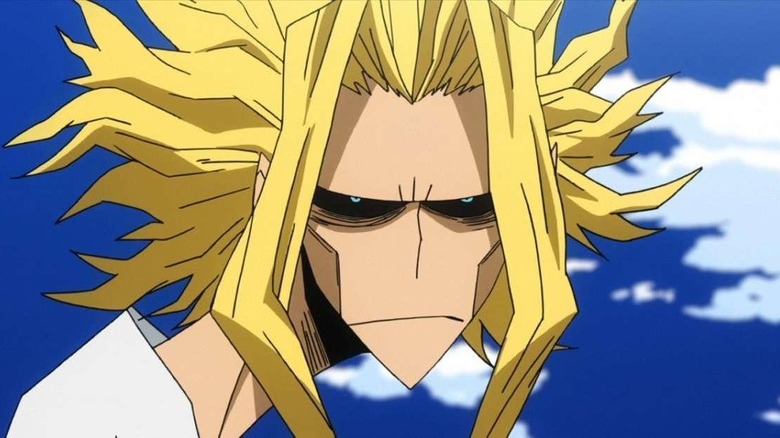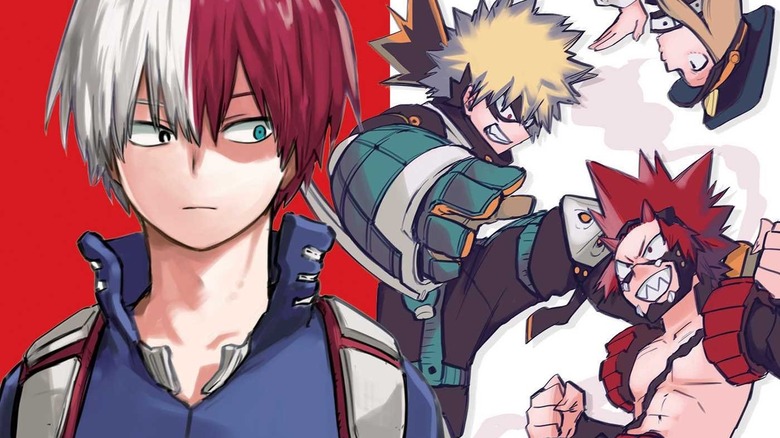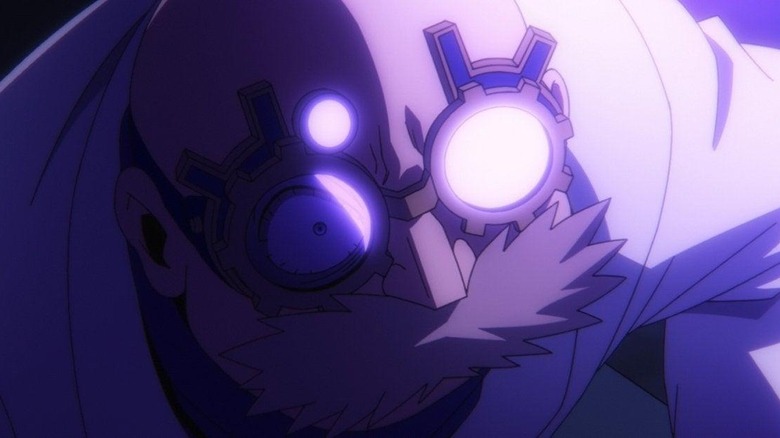The Untold Truth Of My Hero Academia
What do you get when you cross "X-Men" with "Dragon Ball Z?" You get something that looks like "My Hero Academia." Created by Kohei Horikoshi, "My Hero Academia" mixes American superhero themes with the adrenaline, action, and visual storytelling of Japanese anime and manga, particularly the shonen genre. It's a beautiful marriage of two completely different approaches to comics that shows how much one has inspired the other and vice versa. It's also the perfect series to represent the international appeal of superheroes, as well as embody the dominating influence superhero movies and TV shows have on today's pop culture.
Since its release in 2014, "My Hero Academia" has been on the best-selling charts in Japan and North America, selling over 65 million copies worldwide as of January 2022. Meanwhile, the anime series has spawned over 100 episodes and released three theatrical films. The rise of "My Hero Academia" mirrors the growth of Izuku "Deku" Midoriya, a high schooler who goes from being a nobody to becoming a powerful hero. It's an inspiring and engaging story that still continues to hook new fans with its brilliance. Here are some things that even longtime fans may not know about "My Hero Academia."
The members of Class 1-A have meaningful names
Class 1-A consists of 20 amazing students, all of whom possess their own unique superpowers, known as Quirks in the "My Hero Academia" world. However, their Quirks aren't the only thing that makes these kids special. The names of the students in Class 1-A are all more meaningful than they initially appear. For example, the "Asui" in Tsuyu Asui (the show's frog-like hero-in-training) contains the kanji for "frog" (蛙 a) and "puff" (吹 sui), while her first name contains "plum" (梅 tsu) and "rain" (雨 yu). If you write them together, the kanji in Tsuyu's first name translates to "rainy season" (梅雨 tsuyu).
Another example: Tenya Ida's name comes from the Japanese name for Skanda (韋駄天 idaten), the Mahayana protector of Buddhist temples. Idaten is used to represent those with fast speed, such as Tenya and his incredible agility. For Katsuki Bakugo, his surname contains the kanji for "bomb" (爆 baku) and "powerful" (豪 gō), while his first name has the kanji for "to win" (勝 katsu) and "self" (己 ki). A perfect name for the egotistical hero.
Katsuki Bakugo was supposed to be a nice guy
It's impossible to imagine Katsuki Bakugo as anything other than an explosive hothead. However, Bakugo wasn't initially envisioned as the superhero bad boy of "My Hero Academia." He was actually a kinder and gentler character to begin with, Kohei Horikoshi has revealed. His rudeness was going to come from his bluntness, unintentionally insulting others whenever he spoke thoughtlessly. In the end, this nicer version of Bakugo was just too dull for Horikoshi to work with.
Horikoshi traded Bakugo's initial good boy personality for something more antagonizing while keeping the character's intellectual traits. This makes him a far more interesting character, but it's not always easy to keep his meanness in line. In a 2015 interview, Horikoshi admitted that the rudeness Bakugo displays early in the manga — such as telling Izuku Midoriya to jump off a roof — went too far. Not only has Bakugo softened so much since then, he even apologized for his heartless actions in Chapter 322, winning over plenty of fans in the process.
Tsuyu Asui and Toru Hagakure were originally male
The world of superhero comics is generally dominated by male characters. The same can be said for anime and manga that skews toward a young, male audience. When Kohei Horikoshi was developing "My Hero Academia," he soon realized that his draft of Class 1-A was filled with way too many boy characters and not enough girls. Horikoshi altered the gender of two superheroes to increase the representation of women in the classroom.
These two heroes are the loveable frog girl Tsuyu Asui and Toru Hagakure, the adorable invisible girl. In addition to wanting more superhero girls in Class 1-A, Horikoshi also found the concept of a girl with an invisible body to be funnier. His decision to include more female characters in "My Hero Academia" paid off, as Tsuyu often ranks high in popularity polls conducted in both Japan and North America.
Ochaco Uraraka originally had Mt. Lady's powers
Izuku Midoriya's longtime crush was almost a hugely different character. In the original draft of "My Hero Academia," Ochaco Uraraka didn't have her signature gravity-defying powers but instead had the Gigantification Quirk that's associated with Mt. Lady. She also wasn't named "Ochaco Uraraka." She was Yu Takeyama — the secret identity of Mt. Lady in the series — and originally possessed her superhero alter-ego as well. So what happened?
In short, Kohei Horikoshi thought that giving one of the main characters a Quirk as ambitious as gigantism would be too troublesome to handle. Instead, Ochaco was given the power to manipulate gravity, while Yu Takeyama, aka Mt. Lady, became her own character. Ochaco's prototype appearance also inspired the design of Yui Kodai, who shares similar size-manipulating powers as Mt. Lady, but instead of changing her body, Yui can change the size of any nonliving object.
Hizashi Yamada was initially a bald, old man
There's nothing subtle about Hizashi Yamada, better known as the pro hero Present Mic. The English teacher of U.A. High School possesses the electrifying energy of a disc jockey and sports a ridiculously tall haircut. It's a complete 180 from his initial design. According to a character profile featured in the manga, Hizashi was a "chubby old man" who just did the school announcements at first.
Series creator Kohei Horikoshi found this version of Hizashi to be "really boring," which is why he "amped-up" the character. The only evidence of Hizashi's initial design is the word "HAGE" on his headphones, as "hage" means "baldness" in Japanese. Hizashi still retains his announcer role in the anime, as he's the one who provides the explanation of characters and their Quirks. (When it came to explaining his own Quirk, Shota Aizawa took over for Hizashi).
Deku's Batman pose isn't the only Dark Knight nod
It goes without saying that "My Hero Academia" draws its inspiration from the comic books of Marvel and DC. Kohei Horikoshi, the creator of "My Hero Academia," has snuck in some fantastic tributes to the comic book heroes that influenced his work. Perhaps the most blatant example of this is Izuku "Deku" Midoriya striking a pose similar to the Dark Knight on a classic cover, as fans have pointed out on Twitter.
In Chapter 306 of "My Hero Academia," Deku is seen posing like Batman in the second print cover for "Batman" #608, drawn by Jim Lee. The issue in question is part of the beloved storyline known as "Batman: Hush," written by comic book scribe Jeph Loeb and illustrated by Lee. This isn't the only Batman Easter egg to be dropped into the "My Hero Academia" world. In the spin-off title "My Hero Academia: Vigilantes," there's a panel seemingly inspired by the famous image of Batman carrying the murdered Jason Todd from Jim Starlin's classic comic "A Death in the Family."
There's a villain that looks like the Flash
Season 4 of "My Hero Academia" kicked things off with a bang. In Episode 64, the Juko News is trying to write a juicy story about All Might's retirement. However, with the help of freelance journalist Taneo Tokuda, the puff piece becomes an investigation into the identity of All Might's successor. As the anime-original episode flashes back to the younger days of All Might's career, viewers are treated to a brief fight where the muscular superhero is battling a sinister villain that bears a strong resemblance to the DC hero the Flash.
To be exact, the villain's appearance seems to be more inspired by Johnny Quick, the evil counterpart of the Flash from the Crime Syndicate universe. This unexpected DC Comics cameo is just another example of "My Hero Academia" being a love letter to the superhero genre. Considering the heavy population of superheroes and supervillains in the world of "My Hero Academia," the artists behind the show have plenty of chances to pay homage to classic characters when creating brand new ones for Class 1-A to pummel.
Mina Ashido's rejected hero name is a reference to Alien
"My Hero Academia" isn't just a show that only superhero fans can enjoy — it's a treat for all pop culture lovers. A prime example of this is the first proposed superhero name of Mina Ashido from Class 1-A. While everyone knows her as "Pinky," Mina's first attempt at a superhero name was far more original than just naming herself after her skin tone. Mina's original superhero name was Ridley Hero: Alien Queen — a direct reference to Ellen Ripley (Sigourney Weaver) from the "Alien" movie franchise.
On top of being a far more creative name than Pinky, Ridley Hero: Alien Queen would have struck fear in the hearts of enemies, as well as show off Mina's excellent taste in movies. And considering the Xenomorph has acid blood in the films, the name would have complemented Mina's acid powers. Oh, well.
Tenya Ida's initial hero design was creepy
Kohei Horikoshi didn't achieve success with "My Hero Academia" overnight. It took a lot of trial and error to turn his initial draft of a superhero action series into the worldwide phenomenon it is today. Perhaps the strongest difference from prototype to finished product is the character Tenya Ida. Horikoshi has revealed that the character was first thought up during a meeting about serializing the manga, and the initial design would change drastically.
Tenya's preliminary superhero costume was horrific. The class president wore a terrifying helmet in the shape of a dinosaur head, making him look more like an evil villain than a superhero. As for his human design, Tenya was originally a little older and a lot grungier, with baggy jeans and unkempt hair. The character he ultimately became is far more suitable to the school setting that Horikoshi ultimately settled on.
Bubble Girl and Centipeder were made by fans
Not every hero that appears in "My Hero Academia" is a creation of Kohei Horikoshi. Believe it or not, there are two heroes in the series that were created by fans: Bubble Girl and Centipeder. Both heroes were picked as winners in an official fan contest for "My Hero Academia" sponsored by Pixiv, a Japanese online community for artists. Kaoruko Awata, also known as Bubble Girl, was created by Abara Chiita. Juzo Moashi, the Centipeder, was created by Oohara Tetsuya.
Bubble Girl appears in Chapter 124 of the manga, and also in Episode 63 of the anime. The Centipeder showed up in Chapter 134 of the manga, and then appeared in Episode 69 of the anime. This wasn't just a one-and-done deal, as both heroes have made frequent appearances in the series since their official debuts. They also have a connection with each other, as Bubble Girl became the Centipeder's sidekick.
Deku was originally a weak salaryman
"My Hero" walked so "My Hero Academia" could run. Acting as a pilot of sorts, as well as a way to generate hype for the series, the 2008 one-shot became a launching point for the full series. The differences between "My Hero" and "My Hero Academia" are not exactly wholesale, but some of them are hugely significant, especially when it comes to the main character of the story: Izuku Midoriya was originally Jack Midoriya, and instead of being a high schooler, he's a corporate nobody.
In the one-shot, Jack is described as a "weak, puny salaryman" (per Screen Rant) who dreams of being a hero. However, his only contribution to society is selling hero items to others. Another big difference between the two versions of the story is that instead of fighting supervillains, this Deku stand-in ends up fighting monsters called Aberrants. While the signature art style is familiar, "My Hero" is very different from the final product.
Kohei Horikoshi's previous characters make cameos
There's more to Kohei Horikoshi than "My Hero Academia." Before hitting it big with his superhero series, Horikoshi created "Oumagadoki Zoo," a series about a cute and clumsy girl named Hana Aoi who starts to work at a cursed zoo filled with weird creatures. "Oumagadoki Zoo" ran from July 2010 to April 2011 in Weekly Shonen Jump and consists of five manga volumes. While the series wasn't the breakout hit that "My Hero Academia" became, that didn't stop Horikoshi from giving his past beloved characters a new home.
Snake Hero: Uwabami, the celebrity pro hero, is based on a character with the same name in "Oumagadoki Zoo." Kugo Sakamata, also known as the Killer Whale Hero: Gang Orca, is based on the orca Sakamata of "Omagadoki Zoo." While Sakamata was second-in-command of the Ushimitsudoki Aquarium, Gang Orca is the owner of his very own aquarium. As "My Hero Academia" chugs along, there are bound to be more appearances from Horikoshi's past.
Horikoshi believes Superman could beat All Might
If you grew up loving superhero films and/or comic books, you probably debated who would win in fights between your favorite characters with your friends. Debating is part of fandom, but usually there's no way of ever knowing which fictionalized hero would come out on top. Regarding the online debates about All Might vs. Superman (and there have been plenty of those), "My Hero Academia" creator Kohei Horikoshi concedes that Superman could take out his beloved hero.
In a 2018 interview with ComicBook.com, Horikoshi said that the deciding factor in this match would be Superman's laser eyes. "His laser eyes, they are Superman's biggest Quirks," said Horikoshi. "The difference between them, the battle of their Quirks — laser eyes would win." He then cryptically added: "If All Might had that Quirk though..." Seeing All Might do battle with Superman on screen would be a dream come true for many fans, so hopefully we'll get that crossover one day.
There are multiple spin-offs
It wouldn't be a superhero series if it didn't have numerous comic book spin-offs. As a result of the tremendous popularity of "My Hero Academia," various spin-offs have been published that explore different sides of the franchise. There's "My Hero Academia: Vigilantes," a prequel that follows unlicensed superheroes (such as Knuckleduster) that's a lot darker than the mainline series. For a lighter experience, "My Heroine Academia" is a gag manga that centers on the female cast of the series and is really funny.
Then there's "My Hero Academia: Team-Up Missions," a spin-off inspired by the classic "Marvel Team-Up" series that pairs a student with a pro hero. Finally, there's "My Hero Academia: School Briefs," a light-novel spin-off of short stories that takes place between the main story events. As "My Hero Academia" continues to grow in popularity, who's to say there won't be more spin-offs in the future? After all, the "My Hero Academia" universe has a lot of catching up to do with the Marvel Cinematic Universe.
This character's controversial name upset China
The greatest challenge "My Hero Academia" has faced so far in its publication is its controversial decision to name an insidious character after a horrific war crime that occurred during World War II. In Chapter 259 of the manga, it was revealed that the real name of Dr. Daruma Ujiko — a deranged scientist affiliated with the League of Villains — is "Maruta Shiga." What's so bad about that, you may ask? In Japanese, "Maruta" is a word used to reference victims of the human experimentation that took place during World War II. What makes the matter worse is that Daruma Ujiko has conducted human experiments, so the connection appeared intentional. Horikoshi denied this was the case.
"Many have pointed out that the character name 'Shiga Maruta' in this week's Jump chapter has brought up recollections of acts done in the past," he said in a tweet. "I did not intend for that name to be associated as such. I take this matter very seriously and will change the name." Needless to say, many were not happy that the manga had evoked horrendous real-life war crimes that primarily involved Chinese and Korean victims. As a result, China banned "My Hero Academia" from its platforms. Horikoshi apologized for the incident and changed Daruma Ujiko's real name to Kyudai Garaki for future prints of the series.
